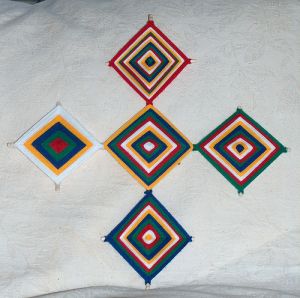Namkha - conjuring with the warp and weft of the elements
Namkha derives from the ancillary Mahayoga section of the Aro gTér. A namkha (sky-weaving) is composed of threads of wool or silk which are the colours of the five elements: blue, green, red, white, and yellow – space, air, fire, water, and earth respectively.
Ngak’chang Rinpoche comments: These threads symbolise the ‘thread’ that is the literal meaning of the word ‘tantra’ and describe the manner in which each point in time and space is the warp and weft of the loom of experiential / existential emptiness.
The threads are woven around a matrix of wooden dowels (srog shing) in a form which displays the basic kyil’khor (mandala) of the elements. The practice of Namkha links our rTsal (externally manifesting energy) with the energy of the five elements. Each elemental colour is associated with a particular experiential stylistic, and represents either the ‘increase’ of non-dual elemental vector or the ‘decrease’ of a pattern of dualistic derangement.
In this practice one observes one’s personal situation and evolves an intuitive notion of which experiential, emotional, or circumstantial manifestation one wishes to increase or decrease via the symbolic structure of the namkha. One then recites the mantra appropriate to the elemental thread one is
weaving (red, white, red, green or blue) around the srog shing matrix. There are a variety of forms that can be woven. This photograph illustrates a basic form, with skies (diamond shaped sections) representing each of the five elements.
The namkha depicted here, has the water element placed in its centre (which would be occupied by the space element in the primary form). The water element has been doubly decreased. The earth element is in the South (its primary position) which has not been increased or decreased. The fire element is in the West
(its primary position) has been increased once. The air element is in the North (its primary position) which has been decreased once. The space element is in the East. The space element is in the east rather than the centre because it has been moved to the East to make way for the water element which has been
moved to the centre. This is because the water element was chosen to be the focus in this namkha. The space element has not been increased or decreased. The meaning of this pattern is that the neurotic patterns are being decreased for water – as the primary focus of the namkha. The liberated qualities of fire have been increased – and the neurotic tendencies of the air element have also been decreased.
Khandro Déchen says of namkha: This is a Mahayoga method of harmonising the energy of our experiential, emotional, and circumstantial personalities. Through the practice of winding a woven matrix of threads—empowered through awareness-spell—we may subtly shift our experience of being in ways which profoundly alter our everyday experience.
Source
[[1]]
